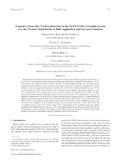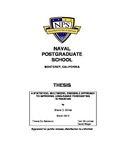The Potential Observation Network Design with Mesoscale Ensemble Sensitivities in Complex Terrain
| dc.contributor.advisor | Hacker, Joshua P. | |
| dc.contributor.author | Chilcoat, Kenneth H. | |
| dc.date | Mar-12 | |
| dc.date.accessioned | 2012-05-14T18:55:36Z | |
| dc.date.available | 2012-05-14T18:55:36Z | |
| dc.date.issued | 2012-03 | |
| dc.identifier.uri | https://hdl.handle.net/10945/6774 | |
| dc.description.abstract | Observation network design requires some framework for sensitivity studies. The goal is to place observations where they will reduce forecast error the most. We use uncertainty estimates from our best forecast models as an indicator of forecast error. The first step is then to find initial-state perturbations that reduce forecast uncertainty by minimizing a user-dependent norm. Adjoint models have helped meet this challenge for decades. More recently, ensemble sensitivities have emerged as a powerful alternative to adjoint models. Under the conditions of Gaussian statistics and an infinite ensemble, lagged covariances from an ensemble can be used equivalently to an adjoint model to give the least-squares minimization of a given cost function. One practical advantage is that costly development and maintenance of tangent linear and adjoint models are avoided. Ensemble sensitivities have been shown to be an effective alternative to adjoint models. They have been used successfully to diagnose predictors of forecast error in synoptic storms, extratropical transition and developing hurricanes. Because they rely on lagged covariances from a finite-sized ensemble, they are subject to sampling error and spurious covariances. However, their efficacy for high-resolution forecasts in mountainous environments has not been thoroughly explored. We present results from experiments designed to establish the potential for ensemble sensitivity computations with a high resolution mesoscale model (grid spacing 4 km) in complex terrain. Using the Weather Research and Forecast (WRF) model and the Data Assimilation Research Testbed (DART) we compute sensitivities with cost functions defined to emphasize parameters affecting fog forecasting in the boundary layer. High sensitivities are interpreted as indicating low predictability for forecasting in the mountains. Results from convergence studies reveal the ensemble sizes needed to robustly estimate the sensitivities. We comment on the implications of results for observation placement and on the expected impact of model inadequacy. | en_US |
| dc.description.uri | http://archive.org/details/thepotentialobse109456774 | |
| dc.publisher | Monterey, California. Naval Postgraduate School | en_US |
| dc.title | The Potential Observation Network Design with Mesoscale Ensemble Sensitivities in Complex Terrain | en_US |
| dc.type | Thesis | en_US |
| dc.contributor.secondreader | Doyle, James D. | |
| dc.contributor.department | Meteorology | |
| dc.subject.author | Mesoscale Ensemble Sensitivity Analysis | en_US |
| dc.subject.author | Ensemble Sensitivities | en_US |
| dc.subject.author | Mesoscale Forecast Sensitivities | en_US |
| dc.subject.author | Observation Network Design | en_US |
| dc.subject.author | ESA | en_US |
| dc.description.service | Captain, United States Air Force | en_US |
| etd.thesisdegree.name | Master of Science In Meteorology | en_US |
| etd.thesisdegree.level | Masters | en_US |
| etd.thesisdegree.discipline | Meteorology | en_US |
| etd.thesisdegree.grantor | Naval Postgraduate School | en_US |
Files in this item
This item appears in the following Collection(s)
-
1. Thesis and Dissertation Collection, all items
Publicly releasable NPS Theses, Dissertations, MBA Professional Reports, Joint Applied Projects, Systems Engineering Project Reports and other NPS degree-earning written works.





